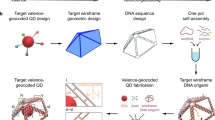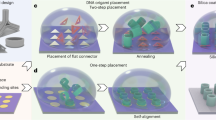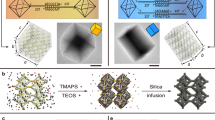Abstract
The self-assembly of nanoscale elements into three-dimensional structures with precise shapes and sizes is important in fields such as nanophotonics, metamaterials and biotechnology1,2. Short molecular linkers have previously been used to create assemblies of nanoparticles3,4,5,6,7,8,9, but the approach is limited to small interparticle distances, typically less than 10 nm. Alternatively, DNA origami10,11 can precisely organize nanoscale objects over much larger length scales. Here we show that rigid DNA origami scaffolds can be used to assemble metal nanoparticles, quantum dots and organic dyes into hierarchical nanoclusters that have a planet–satellite-type structure. The nanoclusters have a tunable stoichiometry, defined distances of 5–200 nm between components, and controllable overall sizes of up to 500 nm. We also show that the nanoscale components can be positioned along the radial DNA spacers of the nanostructures, which allows short- and long-range interactions between nanoparticles and dyes to be studied in solution. The approach could, in the future, be used to construct efficient energy funnels, complex plasmonic architectures, and porous, nanoengineered scaffolds for catalysis.
This is a preview of subscription content, access via your institution
Access options
Subscribe to this journal
Receive 12 print issues and online access
$259.00 per year
only $21.58 per issue
Buy this article
- Purchase on Springer Link
- Instant access to full article PDF
Prices may be subject to local taxes which are calculated during checkout





Similar content being viewed by others
References
Liu, N., Hentschel, M., Weiss, T., Alivisatos, A. P. & Giessen, H. Three-dimensional plasmon rulers. Science 332, 1407–1410 (2011).
Soukoulis, C. M. & Wegener, M. Past achievements and future challenges in the development of three-dimensional photonic metamaterials. Nature Photon. 5, 523–530 (2011).
Alivisatos, A. P. et al. Organization of ‘nanocrystal molecules’ using DNA. Nature 382, 609–611 (1996).
Parak, W. J. et al. Conformation of oligonucleotides attached to gold nanocrystals probed by gel electrophoresis. Nano Lett. 3, 33–36 (2003).
Fu, A. et al. Discrete nanostructures of quantum dots/Au with DNA. J. Am. Chem. Soc. 126, 10832–10833 (2004).
Xu, X., Rosi, N. L., Wang, Y., Huo, F. & Mirkin, C. A. Asymmetric functionalization of gold nanoparticles with oligonucleotides. J. Am. Chem. Soc. 128, 9286–9287 (2006).
Sebba, D. S., Mock, J. J., Smith, D. R., LaBean, T. H. & Lazarides, A. A. Reconfigurable core-satellite nanoassemblies as molecularly-driven plasmonic switches. Nano Lett. 8, 1803–1808 (2008).
Nie, Z., Petukhova, A. & Kumacheva, E. Properties and emerging applications of self-assembled structures made from inorganic nanoparticles. Nature Nanotech. 5, 15–25 (2010).
Gandra, N., Abbas, A., Tian, L. & Singamaneni, S. Plasmonic planet-satellite analogues: hierarchical self-assembly of gold nanostructures. Nano Lett. 12, 2645–2651 (2012).
Rothemund, P. W. K. Folding DNA to create nanoscale shapes and patterns. Nature 440, 297–302 (2006).
Douglas, S. M. et al. Self-assembly of DNA into nanoscale three-dimensional shapes. Nature 459, 414–418 (2009).
Seeman, N. C. Nanomaterials based on DNA. Annu. Rev. Biochem. 79, 65–87 (2010).
Kuzyk, A. et al. DNA-based self-assembly of chiral plasmonic nanostructures with tailored optical response. Nature 483, 311–314 (2012).
Aldaye, F. A. & Sleiman, H. F. Dynamic DNA templates for discrete gold nanoparticle assemblies: control of geometry, modularity, write/erase and structural switching. J. Am. Chem. Soc. 129, 4130–4131 (2007).
Yan, W. et al. Self-assembly of chiral nanoparticle pyramids with strong R/S optical activity. J. Am. Chem. Soc. 134, 15114–15121 (2012).
Zheng, J. et al. Two-dimensional nanoparticle arrays show the organizational power of robust DNA motifs. Nano Lett. 6, 1502–1504 (2006).
Sharma, J. et al. Control of self-assembly of DNA tubules through integration of gold nanoparticles. Science 323, 112–116 (2009).
Ding, B. et al. Gold nanoparticle self-similar chain structure organized by DNA origami. J. Am. Chem. Soc. 132, 3248–3249 (2010).
Pal, S., Deng, Z., Ding, B., Yan, H. & Liu, Y. DNA-origami-directed self-assembly of discrete silver-nanoparticle architectures. Angew. Chem. Int. Ed. 49, 2700–2704 (2010).
Acuna, G. P. et al. Fluorescence enhancement at docking sites of DNA-directed self-assembled nanoantennas. Science 338, 506–510 (2012).
Dietz, H., Douglas, S. M. & Shih, W. M. Folding DNA into twisted and curved nanoscale shapes. Science 325, 725–730 (2009).
Han, D. et al. DNA origami with complex curvatures in three-dimensional space. Science 332, 342–346 (2011).
Liedl, T., Högberg, B., Tytell, J., Ingber, D. E. & Shih, W. M. Self-assembly of three-dimensional prestressed tensegrity structure from DNA. Nature Nanotech. 5, 520–524 (2010).
Bui, H. et al. Programmable periodicity of quantum dot arrays with DNA origami nanotubes. Nano Lett. 10, 3367–3372 (2010).
Deng, Z., Samanta, A., Nangreave, J., Yan, H. & Liu, Y. Robust DNA-functionalized core/shell quantum dots with fluorescent emission spanning from UV-vis to near-IR and compatible with DNA-directed self-assembly. J. Am. Chem. Soc. 134, 17424–17427 (2012).
Dutta, P. K. et al. DNA-directed artificial light-harvesting antenna. J. Am. Chem. Soc. 133, 11985–11993 (2011).
Clapp, A. R., Medintz, I. L. & Mattoussi, H. Förster resonance energy transfer investigations using quantum-dot fluorophores. ChemPhysChem 7, 47–57 (2006).
Pilo-Pais, M., Goldberg, S., Samano, E., LaBean, T. H. & Finkelstein, G. Connecting the nanodots: programmable nanofabrication of fused metal shapes on DNA templates. Nano Lett. 11, 3489–3492 (2011).
Dulkeith, E. et al. Gold nanoparticles quench fluorescence by phase induced radiative rate suppression. Nano Lett. 5, 585–589 (2005).
Anger, P., Bharadwaj, P. & Novotny, L. Enhancement and quenching of single-molecule fluorescence. Phys. Rev. Lett. 96, 113002 (2006).
Acuna, G. P. et al. Distance dependence of single-fluorophore quenching by gold nanoparticles studied on DNA origami. ACS Nano 6, 3189–3195 (2012).
Pal, S. et al. Quantum efficiency modification of organic fluorophores using gold nanoparticles on DNA origami scaffolds. J. Phys. Chem. C 117, 12735–12744 (2013).
Persson, B. N. J. & Lang, N. D. Electron–hole-pair quenching of excited states near a metal. Phys. Rev. B 26, 5409–5415 (1982).
Acknowledgements
The authors thank G. Acuna for discussions and S. Kempter for experimental advice. This work was funded by the Volkswagen Foundation, the DFG through the Nanosystems Initiative Munich (NIM), the ERC through the Advanced Investigator Grant HYMEM, and the EU commission through the Marie Curie Research Training Network ICARUS.
Author information
Authors and Affiliations
Contributions
R.S., J.D., J.F. and T.L. designed the research. R.S., J.D., E.M.R., T.Z., V.S., P.N. and T.L. designed the nanostructures. R.S., J.D., E.M.R., T.Z. and P.N. performed experiments and R.S., J.D. and T.L. wrote the manuscript.
Corresponding author
Ethics declarations
Competing interests
The authors declare no competing financial interests.
Supplementary information
Supplementary information
Supplementary Information (PDF 3240 kb)
Rights and permissions
About this article
Cite this article
Schreiber, R., Do, J., Roller, EM. et al. Hierarchical assembly of metal nanoparticles, quantum dots and organic dyes using DNA origami scaffolds. Nature Nanotech 9, 74–78 (2014). https://doi.org/10.1038/nnano.2013.253
Received:
Accepted:
Published:
Issue Date:
DOI: https://doi.org/10.1038/nnano.2013.253
This article is cited by
-
Nanoscale 3D spatial addressing and valence control of quantum dots using wireframe DNA origami
Nature Communications (2022)
-
Tuning three-dimensional nano-assembly in the mesoscale via bis(imino)pyridine molecular functionalization
Scientific Reports (2022)
-
Sizing up DNA nanostructure assembly with native mass spectrometry and ion mobility
Nature Communications (2022)
-
Design, assembly, and characterization of membrane-spanning DNA nanopores
Nature Protocols (2021)
-
Fabrication and temperature-dependent electrical characterization of a C-shape nanowire patterned by a DNA origami
Scientific Reports (2021)



